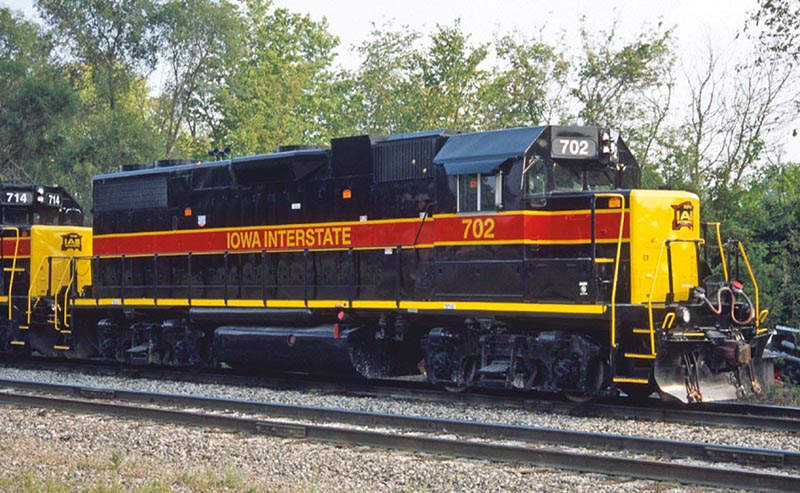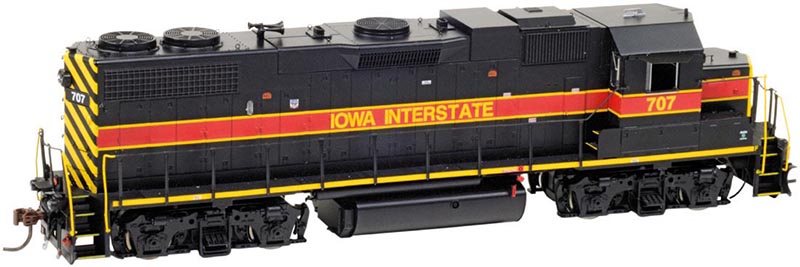By Ryan Crawford/Photos by Tony Cook
In November 1981, a small regional railroad known as the Iowa Railroad (IARR) was formed out of the remnants of the shattered Rock Island. In its infancy, the little IARR operated the former Rock Island main line from Council Bluffs to Atlantic, Iowa. By 1982, IARR entered into a lease to operate the former Rock Island main line from Council Bluffs all the way to Bureau, Illinois. On May 17, 1984, IARR became the Iowa Interstate Railroad (IAIS). At that same time, the railroad saw a sharp increase in business and negotiated a trackage rights agreement in 1985 with Metra and CSX to reach Blue Island, Illinois. In 1987, IAIS secured operating rights on the Bureau to Peoria segment of the former Rock Island. Today, Iowa Interstate trains operate daily from Blue Island to Council Bluffs with one through freight each way daily, including a local from Bureau to Peoria and through trains with Class I railroads serving Peoria.
Iowa Interstate commenced operations with a small fleet of ex-Illinois Central Gulf GP10s and other secondhand fouraxle units. Up until the late 1990s, the railroad also utilized five Alco diesels and a mix of GP38s and GP9s, both rebuilt and originally configured, which it acquired from several different railroads and leasing companies. Up until the purchase of the 700-series GP38-2s in 2004, IAIS entrusted mainline freight duties to a group of 30 first-generation GP7Ms/ GP8s/GP9s/GP10s in the 400 series and a group of nine GP38/GP38ACs in the 600 series. Beginning in July 2008, IAIS received what would become a total of 17 General Electric (GE) ES44ACs. The current roster is comprised of 17 GE ES44ACs, four SD38-2s, and 22 GP38-2s. The GP38-2 fleet is the focus of this review.
 Athearn recently added to its Genesis Phase I GP38-2s with four road numbers for Iowa Interstate’s GP38-2s. The prototypes were purchased from LLPX (Locomotive Leasing Partners). These 22 GP38-2s have a very colorful history. EMD built these units for Penn Central, and they were later conveyed to Conrail in April 1976. The locomotive model being reviewed here is IAIS 707, which was built as Penn Central 7972 in June 1972. It later became Conrail 7972, EMD 772, UP 1926, UP 426, LLPX 2311, and finally purchased by Iowa Interstate in September 2004, becoming its 707. Mid- America Car in Kansas City, Missouri, painted all the IAIS 700-series GP38-2s in the road’s striking black with red stripe scheme.
Athearn recently added to its Genesis Phase I GP38-2s with four road numbers for Iowa Interstate’s GP38-2s. The prototypes were purchased from LLPX (Locomotive Leasing Partners). These 22 GP38-2s have a very colorful history. EMD built these units for Penn Central, and they were later conveyed to Conrail in April 1976. The locomotive model being reviewed here is IAIS 707, which was built as Penn Central 7972 in June 1972. It later became Conrail 7972, EMD 772, UP 1926, UP 426, LLPX 2311, and finally purchased by Iowa Interstate in September 2004, becoming its 707. Mid- America Car in Kansas City, Missouri, painted all the IAIS 700-series GP38-2s in the road’s striking black with red stripe scheme.
MRN’s sample IAIS GP38-2 was carefully assembled. There was no sign of scratches, glue oozing, bent handrails, or poorly aligned grab irons. Athearn’s Genesis model of the prototype has a ton of nice details. It is equipped with a dynamic brake hatch, protruding exhaust stacks, working ditch lights front and rear, knuckle holders on the rear pilot, cab sunshades, a three-chime Leslie S3L horn placed ahead of the front radiator fan. Additionally, the model has hoses on the front and rear pilots, proper style drop steps, sand lines on the trucks, and wire grab irons throughout. Further details include wire lift rings in the proper locations, a prototypically accurate square-type filter hatch, a snow plow, the proper prototype chicken wire radiator grilles at the rear of the carbody, and a toilet vent located in front of the engineer’s pane of cab glass on top of the nose. The bell is also properly located on the engineer’s side under the frame in front of the fuel tank. The close spacing of the radiator fans is another nice attention to detail on these GP38-2s.

The MRN model sample did include a skate-type radio antenna on the roof; however, I could not find any photos of 707 with a skate-type antenna when reviewing prototype photos on the unofficial IAIS website. Also, according to the unofficial IAIS website, the model should have a grab iron directly above the fireman’s side number board on the cab roof. The radiator fans are see-through and include a fan blade assembly, which can be appreciated when viewed from above. The fuel tank has nice detail, including the fuel retention box placed behind the fuel tank with the fuel tank itself being the proper size for an IAIS Phase I GP38-2. One often missed detail on former Conrail models, such as this, is the grab iron placement on the top and side of the short hood nose. EMD moved the grab irons to the opposite side of the nose because Penn Central placed the train control box in front of the cab on the engineer’s side. One odd detail on this IAIS GP38-2 that I discovered while researching the prototype 707 was a small security camera located on the engineer’s side of the rear headlight casting. I am assuming this is a camera used much like a forward-facing camera in larger road locomotives. The IAIS GP38-2s are used in different types of service, which means they are often operated long hood forward, explaining these odd cameras.
Athearn’s very well done paintwork had nice separation lines between the black carbody and the red-and-yellow striping. The words “Iowa Interstate” looked to be in the proper location with no voids. The herald was properly placed on the short nose with the correct color and the correct wording. The accurate number boards contain white numerals in the proper font and size on a black background. The several small warning decals were all legible under magnification and located on the model as per the prototype. This is a nice touch considering there are 12 warning and instructions labels on the prototype. The yellow on the front and rear of the carbody seems to be very close to the prototype; however, I did notice that all the IAIS 700-series GP38-2s do not have classification lights. These lights had been removed sometime before IAIS received them. Another nice detail addition by Athearn is the windshield wipers, which have a cross-over arm between the two middle window wipers. True to prototype form, the Athearn model includes yellow chevrons on the rear of the carbody and a black ECAF box, which is correct for 707. Some of the IAIS 700-series GP38-2s has the stripe painted onto the ECAFB.

Athearn has produced its HO-scale Genesis series Iowa Interstate Phase I GP38-2 in four road numbers: 707, 712, 715, and 718. All four road numbers are available with or without SoundTraxx Tsunami dual-mode sound decoders. The realistic sound of the Tsunami wowed me as I started up the EMD 645 non-turbo diesel prime mover. The excellent sound was crisp and emitted lots of base from the speaker. The locomotive comes with a user manual to adjust the several control variables that are part of the SoundTraxx Tsunami package. I tested the locomotive on my home layout, and I was astounded by its pulling ability. This Athearn Genesis GP38-2 easily handled 30 coal cars on straight and level track. I used it to switch cars in the yard, and it nimbly negotiated the No. 4 and No. 6 turnouts on my layout. It did not stutter or stall during the test.
The wheels were all in gauge, and the McHenry scale-head couplers were mounted at the proper height. The headlights and ditch lights were all in working order; however, I found them to be a bit dim. The use of small LEDs would greatly enhance the lighting on this model. While testing the locomotive, I did hear a slight mechanical growl, which is most likely the gearing and would need several hours of running time to break them in properly.
Athearn has done a fine job of capturing the prototype fidelity of Iowa Interstate’s former Penn Central/Conrail Phase I GP38-2s. For the discerning prototype modeler, it would be an easy project to convert the locomotive into a 100 percent prototypically accurate model of IAIS 707.
This review would not have been possible without the help of the Iowa Interstate Unofficial Photo Archive and Railfans Guide. I would also like to thank diesel locomotive historian Jim Lewnard for his help in preparing this review. Anyone interested in learning more about Iowa Interstate’s operations, history, and HO prototype modeling projects should check out the unofficial IAIS website at www.iaisrailfans.org. Practically anything you want to know about the Iowa Interstate Railroad is on this excellent online resource.



